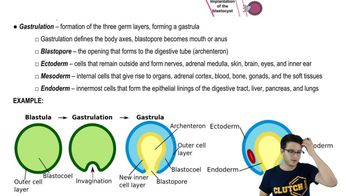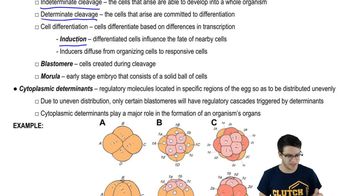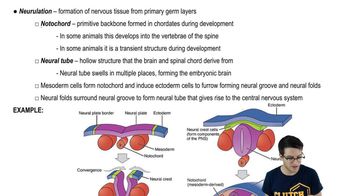Table of contents
- 1. Introduction to Biology2h 42m
- 2. Chemistry3h 40m
- 3. Water1h 26m
- 4. Biomolecules2h 23m
- 5. Cell Components2h 26m
- 6. The Membrane2h 31m
- 7. Energy and Metabolism2h 0m
- 8. Respiration2h 40m
- 9. Photosynthesis2h 49m
- 10. Cell Signaling59m
- 11. Cell Division2h 47m
- 12. Meiosis2h 0m
- 13. Mendelian Genetics4h 44m
- Introduction to Mendel's Experiments7m
- Genotype vs. Phenotype17m
- Punnett Squares13m
- Mendel's Experiments26m
- Mendel's Laws18m
- Monohybrid Crosses19m
- Test Crosses14m
- Dihybrid Crosses20m
- Punnett Square Probability26m
- Incomplete Dominance vs. Codominance20m
- Epistasis7m
- Non-Mendelian Genetics12m
- Pedigrees6m
- Autosomal Inheritance21m
- Sex-Linked Inheritance43m
- X-Inactivation9m
- 14. DNA Synthesis2h 27m
- 15. Gene Expression3h 20m
- 16. Regulation of Expression3h 31m
- Introduction to Regulation of Gene Expression13m
- Prokaryotic Gene Regulation via Operons27m
- The Lac Operon21m
- Glucose's Impact on Lac Operon25m
- The Trp Operon20m
- Review of the Lac Operon & Trp Operon11m
- Introduction to Eukaryotic Gene Regulation9m
- Eukaryotic Chromatin Modifications16m
- Eukaryotic Transcriptional Control22m
- Eukaryotic Post-Transcriptional Regulation28m
- Eukaryotic Post-Translational Regulation13m
- 17. Viruses37m
- 18. Biotechnology2h 58m
- 19. Genomics17m
- 20. Development1h 5m
- 21. Evolution3h 1m
- 22. Evolution of Populations3h 52m
- 23. Speciation1h 37m
- 24. History of Life on Earth2h 6m
- 25. Phylogeny2h 31m
- 26. Prokaryotes4h 59m
- 27. Protists1h 12m
- 28. Plants1h 22m
- 29. Fungi36m
- 30. Overview of Animals34m
- 31. Invertebrates1h 2m
- 32. Vertebrates50m
- 33. Plant Anatomy1h 3m
- 34. Vascular Plant Transport1h 2m
- 35. Soil37m
- 36. Plant Reproduction47m
- 37. Plant Sensation and Response1h 9m
- 38. Animal Form and Function1h 19m
- 39. Digestive System1h 10m
- 40. Circulatory System1h 57m
- 41. Immune System1h 12m
- 42. Osmoregulation and Excretion50m
- 43. Endocrine System1h 4m
- 44. Animal Reproduction1h 2m
- 45. Nervous System1h 55m
- 46. Sensory Systems46m
- 47. Muscle Systems23m
- 48. Ecology3h 11m
- Introduction to Ecology20m
- Biogeography14m
- Earth's Climate Patterns50m
- Introduction to Terrestrial Biomes10m
- Terrestrial Biomes: Near Equator13m
- Terrestrial Biomes: Temperate Regions10m
- Terrestrial Biomes: Northern Regions15m
- Introduction to Aquatic Biomes27m
- Freshwater Aquatic Biomes14m
- Marine Aquatic Biomes13m
- 49. Animal Behavior28m
- 50. Population Ecology3h 41m
- Introduction to Population Ecology28m
- Population Sampling Methods23m
- Life History12m
- Population Demography17m
- Factors Limiting Population Growth14m
- Introduction to Population Growth Models22m
- Linear Population Growth6m
- Exponential Population Growth29m
- Logistic Population Growth32m
- r/K Selection10m
- The Human Population22m
- 51. Community Ecology2h 46m
- Introduction to Community Ecology2m
- Introduction to Community Interactions9m
- Community Interactions: Competition (-/-)38m
- Community Interactions: Exploitation (+/-)23m
- Community Interactions: Mutualism (+/+) & Commensalism (+/0)9m
- Community Structure35m
- Community Dynamics26m
- Geographic Impact on Communities21m
- 52. Ecosystems2h 36m
- 53. Conservation Biology24m
20. Development
Animal Development
Problem 3`
Textbook Question
The archenteron develops into
a. The mesoderm.
b. The endoderm.
c. The placenta.
d. The lumen of the digestive tract.
 Verified step by step guidance
Verified step by step guidance1
Understand the term 'archenteron': The archenteron is an embryonic structure that forms during the early stages of development in animals. It is the primitive gut that forms during gastrulation in the developing embryo.
Identify the process of gastrulation: Gastrulation is a phase early in the embryonic development during which the single-layered blastula is reorganized into a multilayered structure known as the gastrula. This process establishes the three primary germ layers: ectoderm, mesoderm, and endoderm.
Determine the fate of the archenteron: The archenteron is the precursor to the gut. As the embryo develops, the archenteron will eventually become the lumen of the digestive tract.
Differentiate between the germ layers: The endoderm is the innermost layer that lines the archenteron and will give rise to the lining of the digestive and respiratory systems. The mesoderm forms structures such as muscles and the circulatory system, while the ectoderm forms the skin and nervous system.
Conclude the role of the archenteron: Based on the understanding of embryonic development, the archenteron specifically develops into the lumen of the digestive tract, which is option d.
 Verified video answer for a similar problem:
Verified video answer for a similar problem:This video solution was recommended by our tutors as helpful for the problem above
Video duration:
1mPlay a video:
Was this helpful?
Key Concepts
Here are the essential concepts you must grasp in order to answer the question correctly.
Archenteron
The archenteron is an embryonic structure that forms during the early stages of development in animals. It is the primitive gut that develops during gastrulation and eventually becomes the lumen of the digestive tract. Understanding the role of the archenteron is crucial for comprehending how the digestive system forms in the embryo.
Recommended video:
Guided course

Overview of Animals - 2
Gastrulation
Gastrulation is a phase early in the embryonic development of most animals, during which the single-layered blastula is reorganized into a multilayered structure known as the gastrula. This process establishes the three primary germ layers: ectoderm, mesoderm, and endoderm, which are essential for forming various tissues and organs in the body.
Recommended video:
Guided course

Implantion and Gastrulation
Endoderm
The endoderm is one of the three primary germ layers formed during gastrulation. It is the innermost layer and gives rise to the lining of the digestive and respiratory systems, including structures such as the stomach, intestines, and lungs. Understanding the endoderm's role is key to knowing how internal organs develop from embryonic layers.
Recommended video:
Guided course

How Water Enters Xylem
Related Videos
Related Practice




























